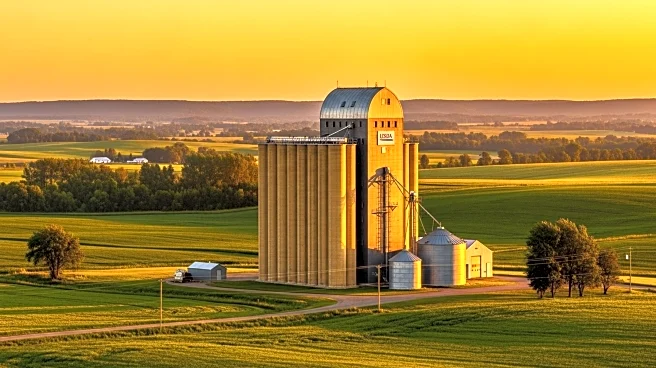What's Happening?
The USDA has announced a policy change that will cease funding for new solar projects on farmland, citing concerns about the loss of agricultural land. This decision comes as solar farms have been criticized for making farmland more expensive and less accessible to traditional farmers. The USDA reports that Tennessee has already lost over 1.2 million acres of farmland, with projections indicating a potential loss of 2 million more acres by 2027. Despite these concerns, some industry leaders argue that solar energy and agriculture can coexist. Matt Beasley, chief commercial officer at Silicon Ranch, asserts that solar farms can provide opportunities to maintain agricultural land while producing energy. Silicon Ranch operates a farm in Franklin, Kentucky, where sheep graze and help maintain vegetation under solar panels, demonstrating a model where renewable energy and farming practices are integrated.
Why It's Important?
The USDA's decision to halt funding for solar projects on farmland highlights the ongoing debate between renewable energy development and agricultural preservation. This policy shift could impact the growth of solar energy, which has been the fastest-growing energy source in the U.S. over the past decade. The decision may affect farmers who have integrated solar energy into their agricultural practices, potentially limiting their business opportunities. Additionally, the restriction on using panels made by foreign adversaries in USDA-funded projects reflects broader concerns about national security and economic independence. The move underscores the challenges of balancing energy needs with agricultural sustainability, a critical issue as the U.S. seeks to transition to cleaner energy sources.
What's Next?
The USDA's policy change may prompt further discussions and studies on the impact of solar farms on agriculture. Stakeholders, including farmers, solar companies, and policymakers, will likely explore alternative solutions to address land access issues while promoting renewable energy. The Tennessee General Assembly's study, which concluded that solar is not a threat to agriculture, may serve as a reference point for future policy considerations. As the U.S. continues to navigate the complexities of energy transition, the integration of solar energy into agricultural practices will remain a topic of interest, potentially influencing future legislative and funding decisions.
Beyond the Headlines
The decision to end funding for solar projects on farmland raises questions about the long-term implications for rural communities and the agricultural sector. The integration of solar energy into farming practices has provided new business models and opportunities for farmers without generational land or experience. The policy change may affect these innovative approaches, potentially limiting economic diversification in rural areas. Additionally, the emphasis on using domestically manufactured solar panels reflects broader economic strategies to bolster U.S. manufacturing and reduce reliance on foreign imports, aligning with national security and economic goals.












